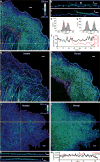Dual-objective STORM reveals three-dimensional filament organization in the actin cytoskeleton
- PMID: 22231642
- PMCID: PMC3304438
- DOI: 10.1038/nmeth.1841
Dual-objective STORM reveals three-dimensional filament organization in the actin cytoskeleton
Abstract
By combining astigmatism imaging with a dual-objective scheme, we improved the image resolution of stochastic optical reconstruction microscopy (STORM) and obtained <10-nm lateral resolution and <20-nm axial resolution when imaging biological specimens. Using this approach, we resolved individual actin filaments in cells and revealed three-dimensional ultrastructure of the actin cytoskeleton. We observed two vertically separated layers of actin networks with distinct structural organizations in sheet-like cell protrusions.
Conflict of interest statement
The authors declare that they have no competing financial interests.
Figures



References
Publication types
MeSH terms
Substances
Grants and funding
LinkOut - more resources
Full Text Sources
Other Literature Sources

